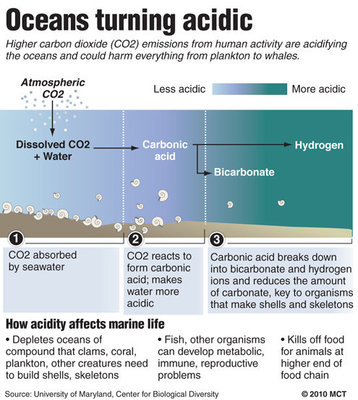Washington – The Environmental Protection Agency is exploring whether to use the Clean Water Act to control greenhouse gas emissions, which are turning the oceans acidic at a rate that’s alarmed some scientists.
With climate change legislation stalled in Congress, the Clean Water Act would serve as a second front, as the Obama administration has sought to use the Clean Air Act to rein in emissions of carbon dioxide and other greenhouse gases administratively.
Since the dawn of the industrial age, acid levels in the oceans have increased 30 percent. Currently, the oceans are absorbing 22 million tons of carbon dioxide a day.
Among other things, scientists worry that the increase in acidity could interrupt the delicate marine food chain, which ranges from microscopic plankton to whales.

“There are all sorts of evils associated with this,” said Robert Paine, an emeritus professor of biology at the University of Washington.
The situation is especially acute along the West Coast. Northwest winds during the summer cause upwelling, which brings deep water to the surface along the continental shelf from Queen Charlotte Sound in British Columbia to Baja California.
The water in the deep Pacific Ocean is already more acidic than shallower water is because it’s absorbed the carbon dioxide that’s produced as animals and plants decompose. Some of the deep water in the Pacific hasn’t been to the surface for 1,000 or more years.
By the end of the century, that deep water is expected to be 150 percent more acidic than it is now, and as it’s brought to the surface by upwelling, it’s exposed to even more carbon dioxide.
“The immensity of the problem on the West Coast is of serious concern,” said Richard Feely, an oceanographer with the National Oceanic and Atmospheric Administration in Seattle.
Scientists suspect that acidic water connected with upwelling killed several billion oyster, clam and mussel larvae that were being raised at the Whiskey Creek Shellfish Hatchery near Tillamook on the Oregon coast in the summer of 2008. The hatchery provides baby shellfish to growers up and down the West Coast.
Shellfish growers in Washington state, who supply one-sixth of the nation’s oysters, increasingly are concerned that corrosive ocean water entering coastal bays could threaten their $111 million industry.
Acid levels in other areas of upwelling — off Africa, South America and Portugal — haven’t been studied as intensely as those off the U.S. West Coast have.
Feely said the oceans’ acidity levels were higher than they’d been at any time in the past 20 million years. Based on “pretty good” evidence, Feely said, previous high acid levels in the oceans have caused mass extinctions of marine plants and animals, which can take 2 million to 10 million years to re-evolve.
“The decisions we make now, over the next 50 years, will be felt over hundreds of thousands of years,” he said.
The Clean Water Act considers high acidity a pollutant, but the standard hasn’t been updated since it was written in 1976. The act has been used previously to help combat acid rain and mercury emissions.
Originally, the Center for Biological Diversity, a San Francisco-based environmental group, asked Washington state to use the Clean Water Act to regulate emissions that add to the ocean’s acidity. Under the act, states have to update their lists of “imperiled waters” every two years and come up with cleanup plans.
In rejecting the request, officials at the state’s Department of Ecology said that while they understood the concern about ocean acidification, there wasn’t enough data about specific bodies of water in the state to justify any listings.
When the EPA agreed with Washington state, the Center for Biological Diversity petitioned the federal agency to start using the Clean Water Act to control the oceans’ rising acidity.
In late March, the EPA published a Federal Register notice seeking public comment on whether the Clean Water Act could be used.
“It’s not 100 percent clear where we go here,” Suzanne Schwartz, the deputy director of the EPA’s Office of Wetlands, Oceans and Watersheds, said in an interview. “This is not an easy issue. We are trying to figure out how to proceed.”
Schwartz said the agency was looking to see whether there were more efficient ways to deal with ocean acidification than using the Clean Water Act. She also said the cleanup mechanism used in the act — controlling total daily maximum loads of pollutants — was aimed more at single sources of pollution than at a broader swath.
“There are questions about how effective the Clean Water Act will be,” she said. “Honestly, we don’t know what we are going to do.”
The public comment period lasts 60 days. Schwartz said the EPA should reach some conclusions by November.
Environmentalists said the Clean Water Act would be a “good fit” with the effort to control carbon dioxide emissions.
“Our overall goal is to get regulation of carbon dioxide under the act,” said Miyoko Sakashita, a lawyer with the Center for Biological Diversity. “I am encouraged by the step EPA has taken. I would like to see them step up before we see some of the worst consequences of ocean acidification.”
Join us in defending the truth before it’s too late
The future of independent journalism is uncertain, and the consequences of losing it are too grave to ignore. To ensure Truthout remains safe, strong, and free, we need to raise $46,000 in the next 7 days. Every dollar raised goes directly toward the costs of producing news you can trust.
Please give what you can — because by supporting us with a tax-deductible donation, you’re not just preserving a source of news, you’re helping to safeguard what’s left of our democracy.
